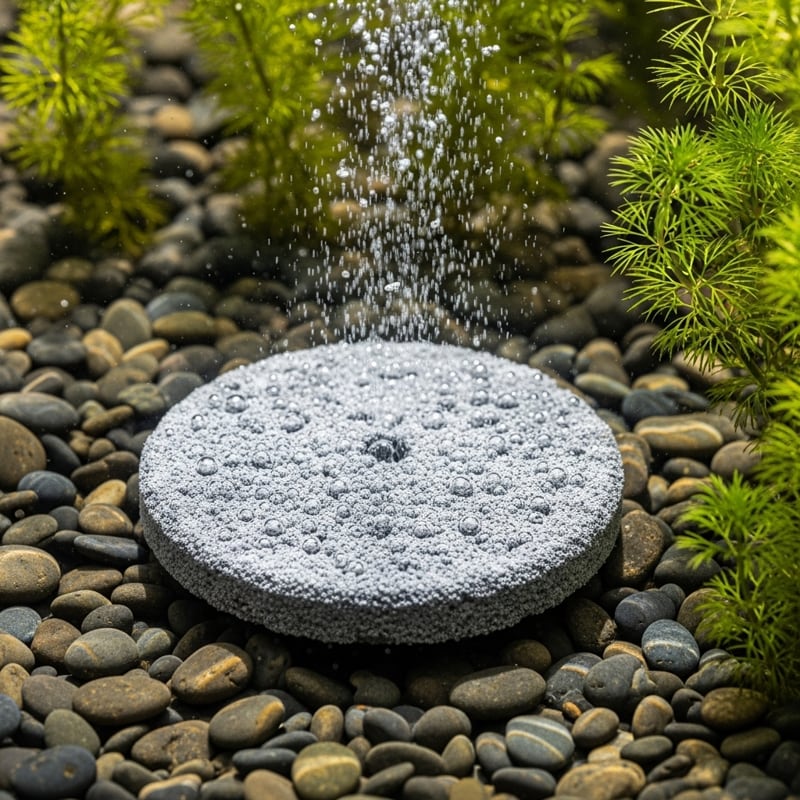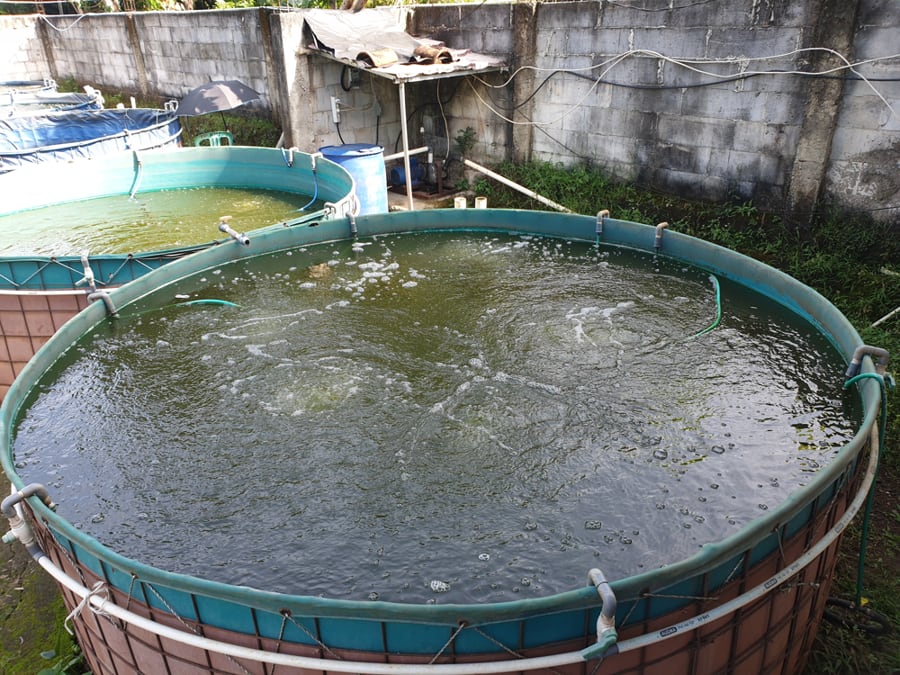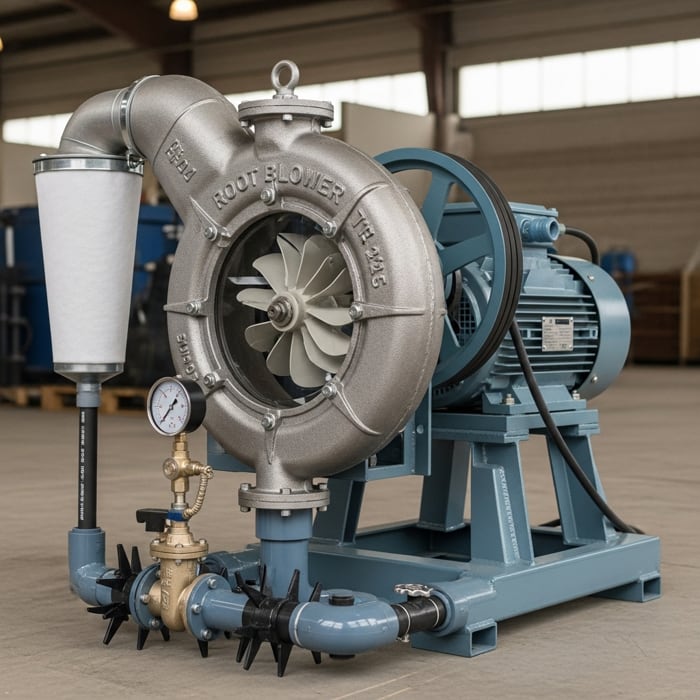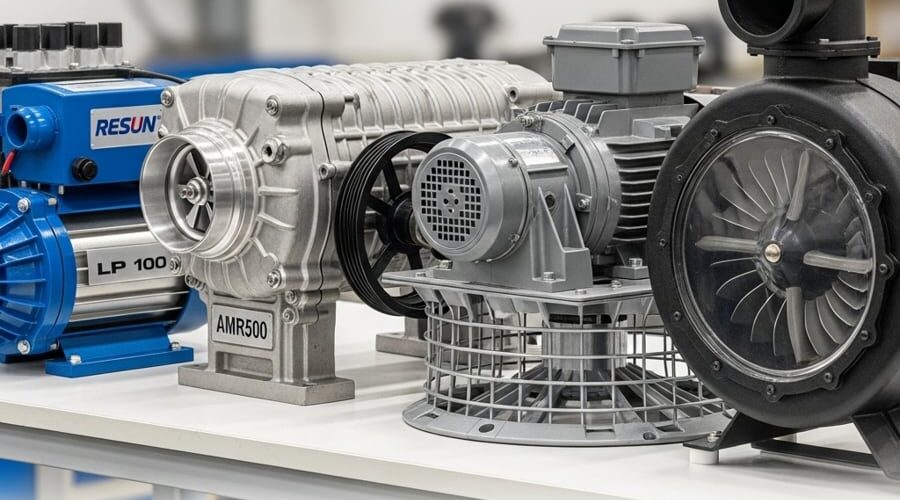Biofloc Pond Aerator: The Heart of Modern Fish Farming Systems
1. What is a Biofloc System?
The biofloc system is a fish farming method that utilizes microorganisms (beneficial bacteria) to process organic waste—especially leftover feed and fish waste—into a floc mass (clumps) that can be re-consumed by the fish. This system relies on pond conditions with intensive aeration and high carbon content, which stimulates the growth of heterotrophic bacterial colonies.
Biofloc is very suitable for cultivation in narrow areas because:
- Reduces the need for water changes,
- Increase feed efficiency,
- Reduce waste pollution to the environment,
- Increase productivity per volume of water.
Types of fish commonly cultivated using this system include catfish, tilapia, and patin.
2. The Importance of Dissolved Oxygen in Biofloc Ponds
In biofloc systems, dissolved oxygen (DO) is one of the most crucial factors. This is due to three main reasons:
- Fish need oxygen to breathe. oksigen can cause stress, slow growth, and even death.
- The heterotrophic bacteria that form floc also need oxygen to break down organic waste into safe and nutritious floc.
- Aerobic (oxygenated) conditions must be maintained so that the biofloc formation process does not turn anaerobic, which can produce toxic compounds such as ammonia and hydrogen sulfide.
Therefore, the ideal DO level in a biofloc system is usually maintained above 5 mg/L continuously, day and night.
3. The Central Role of Aerators in the Success of Biofloc Systems
The aerator is the primary device responsible for maintaining oxygenation and water circulation in a biofloc pond. Its function is not only to provide oxygen, but also to:
- Stir the water so that the biofloc particles remain suspended and do not settle at the bottom of the pond,
- Distribute oxygen evenly, so that there are no dead zones at the bottom or corners of the pool,
- Encourages the circulation of microorganisms, so that the organic waste processing process remains optimal,
- Prevents the formation of toxic gases by keeping the water moving and supplied with oxygen.
Without an aerator, a biofloc system will quickly fail as waste builds up, oxygen depletes, and fish become stressed or die.
Function of Aerator in Biofloc System
1. Maintaining Dissolved Oxygen (DO) Levels
The primary function of an aerator is to introduce oxygen into pond water to meet the needs of fish and microorganisms. In a biofloc system, oxygen is needed not only by fish but also by heterotrophic bacteria that process waste.
Without sufficient aeration, DO (dissolved oxygen) levels can drop drastically—especially at night—causing stress, decreased appetite, and even sudden fish death.
Ideally, DO levels in biofloc ponds should be maintained above 5 mg/L. A good aerator can operate 24/7 to maintain a stable oxygen supply.
2. Helps Water Circulation and Floc Mixing
Aerators also play a role in stirring and circulating pond water, ensuring that the biofloc clumps remain evenly distributed and suspended throughout the pond. Without circulation, the floc will settle to the bottom and lose its function as supplementary feed.
This mixing also helps:
- Distribute nutrients and oxygen evenly,
- Prevent stagnant zones or “dead zones” that lack oxygen,
- Helps fish access flocs at various points in the pond.
3. Prevent Waste Sediment at the Bottom of the Pond
In intensive fish farming, organic waste such as fish waste and leftover feed can quickly accumulate at the bottom of the pond. If left to settle, this waste will decompose and produce toxic gases such as ammonia and hydrogen sulfide.
With optimal aeration:
- Waste sediment can remain suspended and be processed by microorganisms,
- The bottom of the pool stays cleaner longer,
- The risk of water pollution and mass fish deaths can be significantly reduced.
4. Supports the Growth of Microorganisms (Biofloc)
Biofloc systems rely on heterotrophic bacteria, microorganisms that feed on nitrogenous waste and organic carbon. Their metabolic processes require sufficient oxygen and constantly moving water conditions.
Aerator creates:
- An ideal aerobic environment for the growth of good bacteria,
- Stable and evenly distributed living space throughout the pond,
- Healthy, nutrient-dense, and re-eatable flocks (reducing the need for additional feed).
Types of Aerators Commonly Used in Biofloc Systems
1. Paddle Wheel Aerator
Description:
The waterwheel aerator works by rotating blades on the surface of the water, splashing water into the air, so that oxygen from the air is absorbed into the pond.
Excess:
- Very effective in large ponds or open ponds.
- Increase surface water circulation widely.
- Can push leftover food and dirt to a certain point to be sucked up.
Lack:
- Electricity consumption is quite high.
- Not suitable for small tarpaulin ponds or indoor biofloc systems.
- Noise and splashing water can be disturbing if it is near residential areas.

2. Aerator Diffuser (Blower + Aeration Stone)
Description:
Using a blower to pump air into the pond through a hose and air stone (diffuser), produces micro bubbles that distribute oxygen evenly.
Excess:
- Effective in small to medium sized round/tarpaulin pools.
- Circulation and distribution of oxygen is more even to the bottom of the pond.
- Quieter sound, suitable for cultivation in densely populated areas.
- Efficient for biofloc systems as it helps keep the floc suspended.
Lack:
- The initial cost is higher for a quality blower.
- Air stones can become clogged and need to be cleaned regularly.
- Does not create a water current as strong as a waterwheel aerator.
3. Venturi Aerator
Description:
Uses the venturi principle (negative pressure) to mix air into water as it flows through pipes. It's usually integrated with a circulation pump.
Excess:
- Energy saving, no additional blower required.
- Can be combined with a recirculation system or mechanical filter.
- Compact and suitable for small ponds or indoor systems.
Lack:
- Lower oxygenation capacity compared to blowers.
- Effectiveness depends on the speed of water flow.
- Not suitable for high stocking densities without the support of other aerators.
Aerator Comparison:
| Aerator Type | Main Advantages | Main Disadvantages | Suitable for |
| Pinwheel | Strong circulation, wide reach | Wasteful of electricity, not suitable for small pools | Open pond, fishpond |
| Diffuser | Even oxygenation, ideal for biofloc | Need maintenance of aeration stone | Round pond, indoor biofloc system |
| Venturi | Energy saving, integrated with circulation | Not strong enough alone | Small pond, RAS, aeration combination |
Aerator Requirements Based on Pond Size in a Biofloc System
The following explains the need for an aerator based on pond size in a biofloc system, including formulas, examples, and practical tips:
1. Formula or Standard for Oxygen Requirements per Volume of Water/Fish
In biofloc cultivation, oxygen requirements depend on:
- Number and type of fish (stocking density),
- Pool water volume, and
- The activity of biofloc bacteria also requires high oxygen.
General standards for oxygen requirements:
- Catfish/Tilapia: ± 0.2–0.5 grams O₂/hour per kg of active fish biomass
- Biofloc bacteria: ± 0.2–0.4 grams of O₂/hour per m³ of active water
For biofloc systems with high stocking densities (±1000–2000 fish/m³), the total DO requirement can reach 6–8 mg/L to maintain optimal conditions.
2. Examples of Aerator Use Based on Pond Size
Pool Size 1 m³
- Fish capacity: ±1000 catfish of seed/beginner size
- Minimum aerator: 30–40 watt blower + 1 large aeration stone
- Additional option: small venturi if using water circulation
10 m³ pool
- Fish capacity: ±10,000 fish (high stocking density)
- Ideal aerator: 150–250 watt blower, minimum 5–10 diffuser points
- Aeration distribution must be even, can use PVC pipe + aeration stone
Pool area 50 m³
- Fish capacity: ±50,000 fish
- Aerator: 750–1000 watt industrial blower, minimum 20+ aeration points
- Suggested combination: blower + waterwheel for circulation and oxygenation
3. Tips for Choosing the Right Aerator Capacity
- Calculate based on total fish biomass:
For example, 5000 fish x average 150 grams = 750 kg → requires around 150–300 grams of O₂/hour, adjusted to the efficiency of the aerator. - Choose a blower with a pressure of ≥ 0.1–0.2 bar and a minimum air flow capacity of 0.1–0.2 m³/minute per 10 m³ of water.
- Use more than one aeration point per pond, especially in round ponds, to ensure even oxygen distribution and keep the floc suspended.
- Prepare a backup aerator/diesel backup, especially for large ponds or if cultivation runs 24 hours.
- Check the blower/aerator specifications: make sure they match the pressure requirements and number of aeration points.

The Impact of Aerators on Cultivation Productivity in Biofloc Systems
1. The Effect of Aeration on Fish Growth
Optimal aeration maintains high dissolved oxygen (DO) levels, which are crucial for fish metabolism. A stable oxygen supply will:
- Increase the appetite and daily activity of fish,
- Increases digestive efficiency, resulting in faster growth,
- Reduce stress, which can hinder development.
Example:
In catfish cultivation in biofloc ponds, systems with stable aerators (DO > 5 mg/L) are able to achieve harvest 6–8 weeks faster than systems without aerators or with poor aeration.
2. Feed Efficiency and Fish Health
Aerators maintain a clean and stable water environment, allowing biofloc to thrive. Biofloc itself serves as a protein-rich supplementary feed (20–30%).
Impact:
- FCR (Feed Conversion Ratio) can drop from 1.2 to 0.9–1.0.
- The use of commercial feed can be reduced by up to 20–30%.
- Fish are healthier because ammonia and waste residue are decomposed by aerobic bacteria with the help of an aerator.
In addition, the risk of disease decreases because the aquatic environment does not experience a surge in toxic substances due to anaerobic decomposition.
3. Data or Case Studies on Increased Crop Yields Due to Aerators
Contoh Studi Lapangan – Budidaya Lele Bioflok di Klaten, Jawa Tengah
(Sumber: Balai Riset Perikanan Budidaya Air Tawar)
- Without aerator: 2 months of harvest only produces ±80 kg per 1 m³.
- With blower and stable aeration: the harvest yield reaches ±120–130 kg per 1 m³.
- FCR decreased from 1.4 → 1.0, feed costs decreased by ±25%.
- Mortality decreased from 20% to <5%.
Tilapia Biofloc Study – Sukabumi, West Java
With 24-hour active aeration:
- Harvest time is ±20 days faster compared to ponds without aerators.
- The natural biofloc protein content increases, so that tilapia grows more uniformly and healthily.

Innovation and Energy Efficiency in the Use of Aerators for Biofloc Cultivation
1. Energy-saving aerator (DC, solar panel, timer)
As electricity costs rise, many farmers are turning to more energy-efficient aerator systems, including:
- DC (direct current) aerator
Usually used in portable or small scale systems, easily integrated with batteries and solar panels. - Solar Panel-based Aerator (solar power)
● Environmentally friendly and long-term cost-effective
● Suitable for areas without a stable electricity network
● Can be stored in lithium battery for night use - Aerator with Automatic Timer
● Allows the aerator to be turned on and off at certain times (e.g. more active during the day, less active at night)
● High efficiency when combined with fish diet and activity patterns
Note: This system is very suitable for small-medium cultivation ponds in rural areas.
2. DO Sensor-Based Aeration System Automation
The DO (Dissolved Oxygen) sensor allows the aerator to turn on or off automatically based on the oxygen levels needed in the water.
Profit:
- Mencegah over-aerasi (pemborosan energi)
- Maintain DO at the optimal range consistently (5–7 mg/L)
- Can be connected to an alarm system if DO drops drastically (danger sign)
⚙️ Some modern systems also use:
- Digital DO controller
- Automatic relay
- Connection to smartphone or IoT dashboard
3. Potential Integration with Smart Farming Systems
Aeration systems are now starting to be integrated into IoT-based smart farming platforms, which combine:
- DO, temperature, pH, and water turbidity sensors
- Feed and aerator automation
- Real-time monitoring via application
Benefits of smart system integration:
- Energy saving and operational cost efficiency
- Historical data can be used for decision making
- Direct notification to mobile phone if system failure occurs
Application example:
Biofloc catfish farming system with solar aerator + DO sensor + auto feeder, can reduce electricity costs by up to 40% and increase survival rate >95%.
Berikut adalah bagian Closing untuk artikel tentang aerator dalam sistem bioflok:
Closing
Aerators play a key role in the success of a biofloc system. By maintaining dissolved oxygen levels, aiding water circulation, and supporting the growth of microorganisms, aerators not only maintain fish health but also significantly increase feed efficiency and crop yields.
Without proper aeration, the entire biofloc ecosystem can be disrupted—from fish stress, degraded water quality, to the risk of mass mortality. Therefore, selecting and managing a proper aerator system is essential for anyone seeking success in intensive and sustainable fish farming.
Use an aerator that suits the pond's needs and the culture volume, and consider energy efficiency and technological innovation for optimal results. This way, we not only maintain productivity but also contribute to an environmentally friendly aquaculture system and a brighter future for fisheries.

